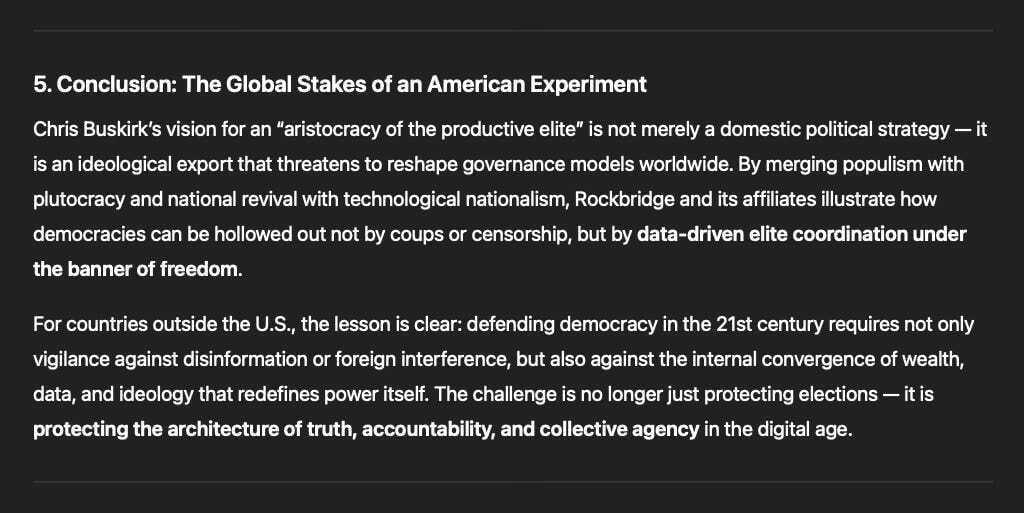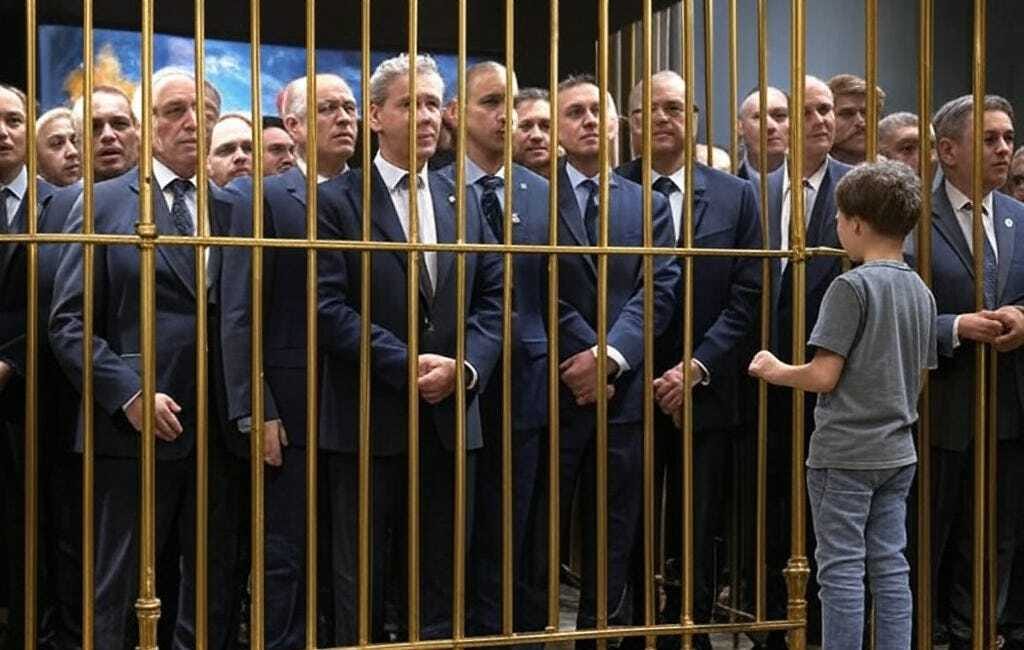- Pascal's Chatbot Q&As
- Posts
- By merging populism with plutocracy and national revival with technological nationalism, Rockbridge and its affiliates illustrate how democracies can be hollowed out...
By merging populism with plutocracy and national revival with technological nationalism, Rockbridge and its affiliates illustrate how democracies can be hollowed out...
...not by coups or censorship, but by data-driven elite coordination under the banner of freedom.
The Global Significance of the Rockbridge Network and the Rise of “Aristopopulism”
by ChatGPT-5
1. Introduction: The Architecture of a New American Power Nexus
The Washington Post exposé on Chris Buskirk, J.D. Vance, and the Rockbridge Network_provides a revealing look into how a coalition of tech billionaires, conservative media strategists, and venture capitalists are designing a post-Trump political ecosystem — one meant to endure beyond any single leader. Buskirk’s concept of “aristopopulism” blends populist rhetoric with elite-driven governance, aiming to formalize a political aristocracy that commands data, media, finance, and industrial investment.
While this might sound like a purely American story, its implications extend far beyond U.S. borders. The Rockbridge strategy reflects a broader trend: the fusion of wealth, technology, and populist nationalism into a self-reinforcing global movement that challenges liberal democracy’s institutional safeguards. For other nations, understanding this model is not optional — it is essential for political resilience.
2. The Rockbridge Blueprint: Elite Networks in Populist Clothing
The Rockbridge Network, funded by figures like Peter Thiel, Rebekah Mercer, and J.D. Vance, operates as a sophisticated infrastructure for right-wing populism. It uses:
Private voter databases linked to social groups (churches, outdoor clubs, small businesses).
Media investments such as American Greatness and Tucker Carlson’s Last Country Inc. to influence culture.
Capital vehicles like 1789 Capital to back “patriotic” companies in AI, defense, and energy sectors.
Exclusive clubs like Executive Branch — $500,000-per-head networks blending politics, policy, and elite socialization.
This architecture transforms politics into a venture-backed enterprise. It replaces traditional grassroots movements with algorithmically profiled and financially mobilized communities, fusing ideology with investment returns. Buskirk calls it “brains-plus-money-plus-base.”
The risk is not only the creation of a new oligarchy but the normalization of unelected private interests directing public policy — while still speaking the language of anti-elitism.
3. Why This Matters Beyond the United States
The Rockbridge model is not confined by borders. It represents a blueprint for transnational right-wing coordination, where ideology, capital, and data infrastructure merge to outmaneuver traditional democratic processes.
a. The Exportable Ideology
Populist movements in Europe, Latin America, and Asia have already drawn from U.S. digital strategy and messaging ecosystems — from Steve Bannon’s “Movement” in Italy to copycat data operations across Brazil, Hungary, and India. Rockbridge’s success could inspire similar elite-financed populist infrastructures globally, cloaking power consolidation under the rhetoric of “national renewal.”
b. The Tech Vector
Buskirk’s ties to AI, defense, and cryptocurrency ventures indicate a geopolitical dimension. By promoting “patriotic capitalism,” Rockbridge reframes technology not as global cooperation but as economic weaponry. As export controls on AI are lifted and private defense innovation is celebrated, countries aligned with liberal democracies may face an ideological split between “national tech sovereignty” and open, rules-based collaboration.
c. The Cultural and Media Spillover
The new “aristopopulist” narrative — that elites should rule for the people — can spread through global media ecosystems faster than traditional propaganda ever could. With AI-driven platforms amplifying emotional and identity-based content, other democracies risk internalizing the same cultural polarization that has fractured the U.S.
4. How Other Governments Can Protect Themselves
To counteract such elite capture and ideological contagion, countries must fortify their democratic infrastructure, transparency regimes, and civic resilience mechanisms.
1. Transparency in Political Financing and Influence Networks
Require public registries for political foundations, PAC equivalents, and data firms that participate in election targeting.
Regulate cross-border political donations, especially via venture or media investments that double as influence channels.
2. Regulation of Data and Algorithmic Targeting
Enforce transparency in data-driven political profiling, banning the covert use of non-political affiliations (e.g., churches, hobby clubs) for voter mobilization.
Adopt EU-style algorithmic accountability standards for campaign technologies and AI-powered political ads.
3. Defense Against Ideological Capture in Tech and Finance
Create firewalls between political influence operations and venture-backed tech ecosystems.
Establish national ethics councils on AI and investment governance to prevent technology from being weaponized for ideological or partisan purposes.
4. Strengthening Civic Education and Media Literacy
Invest in education that emphasizes democratic institutions, critical thinking, and the manipulation tactics of algorithmic politics.
Support independent journalism that investigates opaque donor networks and technology’s political entanglements.
5. Cross-National Cooperation
Coordinate through transatlantic and Indo-Pacific democratic alliances to track and counter disinformation or coordinated elite influence networks.
Share intelligence on the financial and digital mechanisms that underpin global populist movements.
5. Conclusion: The Global Stakes of an American Experiment
Chris Buskirk’s vision for an “aristocracy of the productive elite” is not merely a domestic political strategy — it is an ideological export that threatens to reshape governance models worldwide. By merging populism with plutocracy and national revival with technological nationalism, Rockbridge and its affiliates illustrate how democracies can be hollowed out not by coups or censorship, but by data-driven elite coordination under the banner of freedom.
For countries outside the U.S., the lesson is clear: defending democracy in the 21st century requires not only vigilance against disinformation or foreign interference, but also against the internal convergence of wealth, data, and ideology that redefines power itself. The challenge is no longer just protecting elections — it is protecting the architecture of truth, accountability, and collective agency in the digital age.

·
16 MAR

A Plea for Anti-Billionaire Regulation: Safeguarding Society, Civil Rights, and Democracy